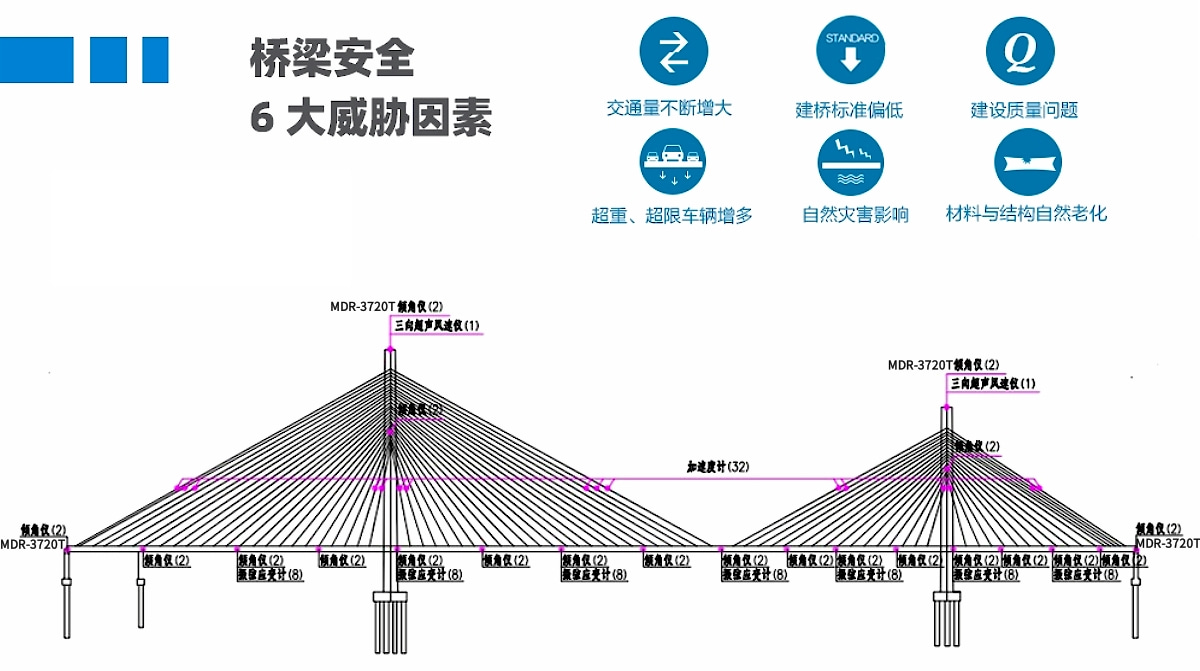感谢您的支持,我会继续努力的!



打开支付宝扫一扫,即可进行扫码打赏哦
As the world's largest bridge country, China has about 100000 large urban bridges, about 70000 railway bridges and more than 800000 highway bridges. In the whole life cycle of the bridge, the maintenance period accounts for 90% of the bridge life. The long-term normal use of the bridge depends not only on the construction quality, but also on the management and maintenance level in the later stage. The traditional inspection methods have many shortcomings, such as requiring a lot of manpower, material resources and financial resources, affecting the normal traffic operation, long cycle, and poor real-time performance, which limit its direct and effective application in the health monitoring and early warning of large bridges.
With the development of the Internet of Things technology, especially the maturity of high-precision inclination sensor technology, the bridge health monitoring system integrating modern testing and sensing technology, network communication technology, signal processing and analysis technology, mathematical theory and structural analysis theory and other disciplines can greatly extend the content of bridge online monitoring, and can continuously, real-time and online monitor and evaluate the "health" status of the structure, It has great guiding significance for the operation safety of bridges and the improvement of the management level of bridges.
In bridge health monitoring, inclinometers are usually arranged on the bridge deck, tower, pier and suspension cable to measure the deformation of the bridge under load and evaluate the integrity and stability of the bridge structure. Among them, the main purpose of bridge deck deformation monitoring is to determine the important technical parameters such as the stiffness and structural bearing capacity of the bridge in the vertical direction, which are the key reference indicators in the process of bridge identification, reconstruction and new bridge acceptance. Bridge tower is another place that needs to be measured by inclination sensor. The inclination value of bridge tower, to a certain extent, reflects whether the integrity and stability of the bridge structure is affected, and then whether it will endanger the safety of the bridge.
The monitoring items of super-large bridges can be divided into two parts: load source and structural static and dynamic response. The general principles for determination are as follows:
1. Principles for selection of monitoring items
① According to the importance of various structural components of the bridge in structural safety and the vulnerability of components;
② According to the geographical environment and climatic environment characteristics of the bridge, determine the factors affecting the stress of the bridge structure;
③ Starting from the needs of structural state assessment and operation and maintenance management, it is necessary to make technical preparations for future state identification and structural safety evaluation;
④ The special structure of the bridge should be monitored;
⑤ According to the characteristics of the bridge, capital investment and economy, real-time monitoring and regular monitoring are combined to realize bridge monitoring and early warning.
2. Based on the above principles, combined with the operating environment characteristics and structural stress characteristics and structural characteristics of the bridge site, the monitoring items are divided into environmental parameters and load sources, structural response monitoring, structural durability monitoring and other monitoring:
(1) Load source monitoring items:
① Wind load (including wind speed and direction);
(2) Structural response monitoring:
① Main beam displacement monitoring; ② Stress and strain monitoring; ③ Cable force monitoring of stay cables; ④ Tower inclination monitoring;
The principle of product selection is: 1 Select the current international advanced technical equipment to ensure the good accuracy, stability, durability and scalability of the system; 2. Select products with good versatility and easy procurement in the market to ensure the maintainability and replaceability of the system; 3. Select products with high performance-price ratio to ensure the best operation of the system at the lowest cost and realize bridge monitoring and early warning; 4. The system has reached the international advanced level. MDR-3600 series ultra-high precision inclination sensing instruments produced by Dexair are selected as high-precision inclination sensing instruments, with sampling frequency of 1Hz.

关注公众号
了解更多传感器知识
公众号:德克西尔

加微信
购买传感器产品
微信号:Drksir-13515810281
